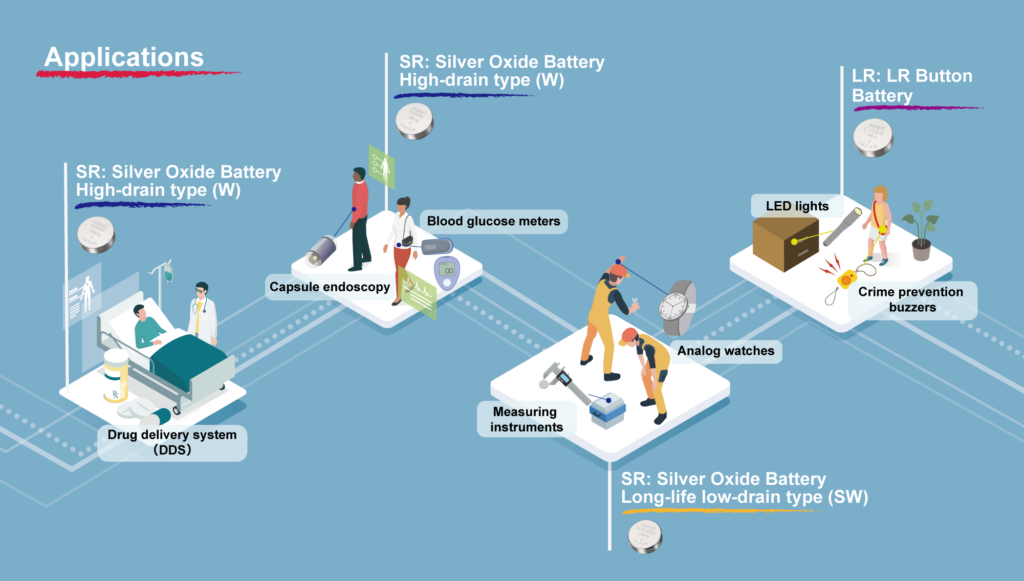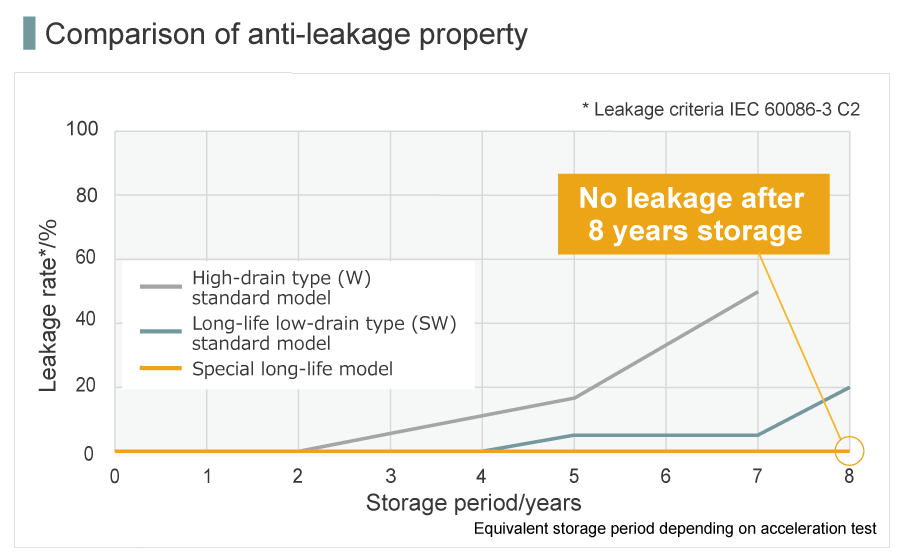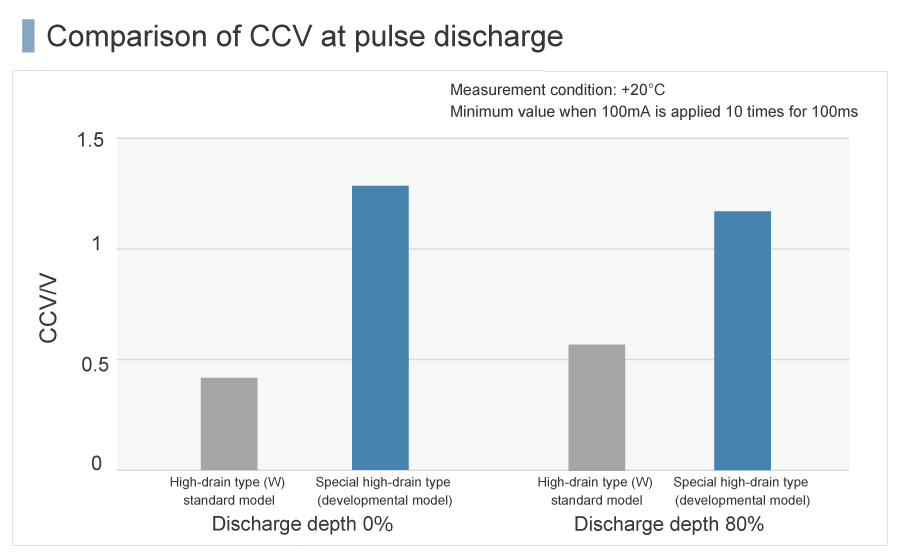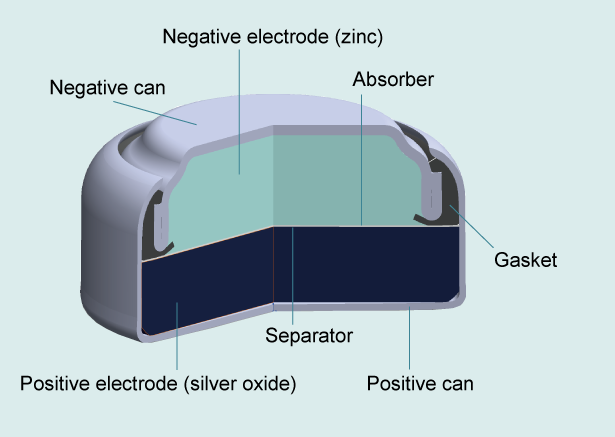SR (Silver Oxide Battery)/LR (LR Button Battery)
Long-life low-drain (SW) and high-drain (W) battery range

Maxell successfully commercialized the first SR button-type silver oxide battery in Japan in 1976. It has been adopted for small electronic devices based on 45 years of manufacturing experience and quality.
The silver oxide battery is a primary battery that mainly uses silver oxide as the positive electrode active material, zinc as the negative electrode active material, and an aqueous alkali solution as the electrolyte solution.
Due to its high energy per unit volume and stable operating voltage characteristics, it became established as a power supply for quartz watches (analog watches) requiring high accuracy. In recent years, applications have expanded to a wide range of fields such as medical devices equipped with Bluetooth® Low Energy (BLE).
Maxell is manufacturing all models of silver oxide batteries and alkaline button batteries without using mercury and lead, with the aim of reducing their environmental impact. Maxell meets customers’ requests with an extensive lineup. For details, please contact Maxell.
*Bluetooth Low Energy is a registered trademark of US Bluetooth SIG, Inc.
Applications
SR: Silver Oxide Battery
- Analog watches
- Digital watches
- Measuring instruments
- Calculators
- Medical instruments
- BLE devices
LR: LR Button Battery
- Toys
- LED lights
- Crime prevention buzzers
- Medical thermometers

Product Range
Differences between long-life low-drain type (SW) and high-drain type (W) batteries
Maxell offers multiple types of silver oxide batteries to support a wide range of applications.
Types that have no alphabetical character at the end are used for other general-use devices.
Long-life low-drain type (SW)
High-drain type (W)
Suitable for equipment that requires high power such as multifunction digital watches equipped with backlights,
stopwatches and alarm functions, medical equipment, and Bluetooth® Low Energy (BLE) equipment.
*Bluetooth Low Energy is a registered trademark of US Bluetooth SIG, Inc.
Maxell has been developing “special specification” batteries in addition to their standard long-life low-drain type (SW) and high-drain type (W) to meet such market demands as long life and multi-functionalization, which in recent years are required for small electronic devices.
Special specification Long-life silver oxide battery
A special long-life silver oxide battery designed for long-life applications has about double the leakage resistance of long-life low-drain type (SW) standard models. For this reason, this model is especially suitable for equipment that is used for long periods of time.

Special specification High-drain type (developmental model)
The special high-drain type (developmental model) has about three times the load characteristics of high-drain (W) standard models. Consequently, it can be used for equipment that requires a higher current than previously required.

SR: Silver Oxide Battery
Stable operating voltage and high capacity
Silver oxide and zinc are respectively used as the main positive electrode and negative electrode active materials, and the operating voltage is stable during discharge. It has high energy density per unit volume and can attain higher capacities than those of alkaline button batteries.Superior load characteristics
Excellent load discharge characteristics are possible due to the adoption of an alkaline electrolyte.The long-life low-drain type (SW), suitable for equipment that operates for long periods of time with light loads such as analog watches, and the high-drain type (W), suitable for equipment that is expected to be used for short periods of time with heavy loads such as medical equipment and multifunction digital watches with alarms and LED lights, are configured according to electrolyte composition.
Superior leakage* resistance
Featuring Maxell’s original leak-resistant processing, the SR battery has excellent leakage resistance, which suppresses the electrolyte from rising up and seeping out — a basic phenomenon of alkaline electrolytes.
(* Leakage is defined as an unintended escape of liquid from a battery.)Excellent capacity retention rate
Original negative electrode material composition shows superior capacity retention rate. For the main models, the SR920SW, SR626SW, and SR621SW, an annual capacity deterioration rate of about 2% has been achieved for standard capacity.Mercury-free
Although mercury was previously added to silver oxide batteries to prevent the degradation of battery performance, Maxell has realized superior leakage resistance without using mercury or lead, producing “mercury-free” batteries across all models, based on Maxell’s unique technology.Consideration for the environment
All models of Maxell’s silver oxide batteries are manufactured without using mercury or lead as part of Maxell’s efforts to reduce its environmental impact. For this reason, these batteries comply with the EU Battery Directive.
Specifications
Long-life low-drain(SW)
*Nominal capacity indicates the duration until the voltage drops to 1.2V when discharged at a nominal discharge current at 20 deg. C.
High-drain type(W)
General use
LR Button Battery
- All models are “mercury free”
- Maxell’s silver oxide batteries comply with the EU Battery Directive and are manufactured without intentionally adding mercury to the battery materials.
- Data and dimensions are not guaranteed. For further details, please contact us at your nearest Maxell office.
- Contents on this website are subject to change without notice.
Construction (SR: Silver Oxide Battery)

Principle and Reactions
| Positive reaction : | Ag 2 O+H 2 O+2e - → 2Ag+2OH - |
|---|---|
| Negative reaction : | Zn+2OH - → ZnO+H 2 O+2e - |
| Total reaction : | Ag 2 O+Zn → 2Ag+ZnO |
| Total reaction : | 2MnO 2 +Zn+H 2 O → 2MnOOH+ZnO |
|---|
Safety precautions
If misused, this battery may deform, leak (the liquid inside the battery may leak to the outside), generate heat, explode, or ignite.
Since such misuse may cause injury or equipment failure, please be sure to read and observe [Warnings and Cautions].
Glossary of Battery Terms
Direct contact electrically between the positive electrode and negative electrode caused by damage to the separator or gasket, or the presence of a conductor piercing the separators. A battery will become completely exhausted before use.
Surges of current across the terminals of a battery when it is short-circuited.
Enduring characteristics against leakage.
Ratio of usable capacity against theoretical capacity.
Medium in a battery which causes ions to move to create an electrochemical reaction. Either water or non-aqueous solution is used as solvent. The latter is called non-aqueous electrolyte solution, either organic or inorganic.
Electrode materials in a battery which cause an electrochemical reaction to generate electricity.
Ex)
Battery Type / Positive material / Negative material
LR / Manganese Dioxide / Zinc
CR / Manganese Dioxide / Lithium
Expiration of guarantee period of a primary battery determined by each manufacturer conforming to the IEC. Because a secondary battery can be used over again by charging, it is unnecessary to show this.
Note: IEC (International Electrotechnical Commission) is a worldwide organization of standardization comprised of all national electrotechnical committees.
A finished or semi-finished battery is store under specified conditions for a specified period.
Test conducted within 2 weeks after storage.
Store the battery under specified conditions.
Test conducted within 2 months of the production month.
Usable energy of a battery per unit volume or unit weight. The former is called volumetric energy density (Wh/l); the latter gravimetric energy density (Wh/kg).
Capacity (Ah, mAh) is the product of the discharge current (A, mA) and discharge time (h). Note: Because manganese dry batteries and alkaline manganese batteries are often used for heavy-duty applications, the discharge time at a specific load is usually mentioned instead of the capacity.
Time until a battery voltage exceeds the end-point voltage during discharge.
Voltage deviation from equilibrium caused by charge or discharge.
Operation during which a reverse reaction of discharge occurs when electrical energy is received from an external source.
Change of a battery voltage with discharge.
Decreasing capacity during storage without load, caused by chemical reaction in a battery. The higher the temperature during storage, the greater the rate of self discharge.
Continue to discharge after a battery voltage drops below its end-point voltage.
Operation during which a battery delivers current to an external circuit.
Resistant component in a battery that makes discharge reaction slow.
Specified closed circuit voltage at which a service output test is terminated.
External device or method through which a battery is discharged.
Suitable approximate value of voltage used to identify the voltage of a battery.
For example)
Alkaline manganese battery; 1.5V
Lithium manganese dioxide battery; 3.0V
Voltage across the terminals of a battery when it is on discharge. As a battery has an internal resistance, CCV is lower than OCV and CCV becomes lower with a range of current.
Voltage across the terminals of a battery when no external current is flowing.
Source of electrical energy obtained by the direct conversion of chemical energy designed to be charged by any other electrical source. It is also called a storage battery or accumulator.
Source of electrical energy obtained by the direct conversion of chemical energy and not designed to be charged by any other electrical source.
Contact Us
If you think CR Batteries might be of interest for your project and you need some more information, please complete the form below and someone will get in contact with you shortly.

